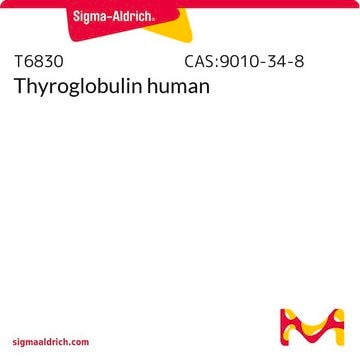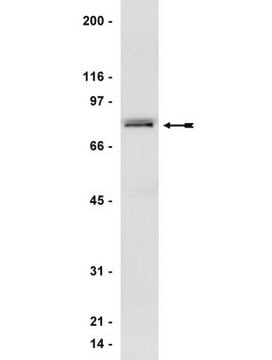407331
ILK inhibitor, Cpd 22
The ILK inhibitor, Cpd 22 controls the biological activity of ILK. This small molecule/inhibitor is primarily used for Phosphorylation & Dephosphorylation applications.
Synonym(s):
ILK inhibitor, Cpd 22
Sign Into View Organizational & Contract Pricing
All Photos(1)
About This Item
Empirical Formula (Hill Notation):
C30H30F3N5O
Molecular Weight:
533.59
UNSPSC Code:
12352200
NACRES:
NA.77
Recommended Products
Quality Level
Assay
≥94% (HPLC)
form
powder
manufacturer/tradename
Calbiochem®
storage condition
OK to freeze
protect from light
color
off-white
solubility
DMSO: 100 mg/mL
shipped in
ambient
storage temp.
2-8°C
General description
A cell-permeable, tri-substituted pyrazol compound that acts as a potent and specific integrin-linked kinase (ILK) inhibitor (IC50 = 600 nM). Shown to have high in vitro anti-proliferative potency against prostrate and breast cancer cell lines (IC50 = 1 to 2.5 µM) while sparing normal epithelial cells. Its effect on cancer cells have been attributed to induction of autophagy and apoptosis. Suppresses ILK-mediated phosphorylation of Akt at Ser473 site, thereby down-regulating the downstream targets, such as GSK-3b and myosin light chain. Also causes a transcriptional repression of the transcription factor Y-Box binding protein 1 (YB-1). Exhibits minimum toxicity in mouse model.
A cell-permeable, tri-substituted pyrazol compound that acts as a potent and specific integrin-linked kinase (ILK) inhibitor (IC50 = 600 nM). Shown to have high in vitro anti-proliferative potency against prostrate and breast cancer cell lines (IC50 = 1 to 2.5 mM) while sparing normal epithelial cells. Its effect on cancer cells have been attributed to induction of autophagy and apoptosis. Suppresses ILK-mediated phosphorylation of Akt at Ser473 site, thereby down-regulating the downstream targets, such as GSK-3b and myosin light chain. Also causes a transcriptional repression of the transcription factor Y-Box binding protein 1 (YB-1). Exhibits minimum toxicity in mouse model.
Packaging
Packaged under inert gas
Warning
Toxicity: Standard Handling (A)
Reconstitution
Following reconstitution, aliquot and freeze (-20°C). Stock solutions are stable for up to 3 months at -20°C.
Other Notes
Lee, S., et al. 2011. J. Med. Chem.54, 6364
Legal Information
CALBIOCHEM is a registered trademark of Merck KGaA, Darmstadt, Germany
Storage Class Code
11 - Combustible Solids
WGK
WGK 1
Flash Point(F)
Not applicable
Flash Point(C)
Not applicable
Certificates of Analysis (COA)
Search for Certificates of Analysis (COA) by entering the products Lot/Batch Number. Lot and Batch Numbers can be found on a product’s label following the words ‘Lot’ or ‘Batch’.
Already Own This Product?
Find documentation for the products that you have recently purchased in the Document Library.
Sacha Robert et al.
International journal of molecular sciences, 22(19) (2021-10-14)
Differentiation of pluripotent stem cells to cardiomyocytes is influenced by culture conditions including the extracellular matrices or similar synthetic scaffolds on which they are grown. However, the molecular mechanisms that link the scaffold with differentiation outcomes are not fully known.
Seda Mehtap Sarı Kılıçaslan et al.
Iranian journal of basic medical sciences, 24(11), 1500-1508 (2022-03-24)
This study examines the impact of integrin-linked kinase (ILK), protein kinase B (AKT), glycogen synthase kinase-3β (GSK-3β), and β-catenin signal molecules in SKOV-3 ovarian cancer cells adhered to fibronectin. Expression levels of α4, αv, β1, and β6 integrin subunits known
Constanza Garcia-Keller et al.
Biological psychiatry, 86(5), 377-387 (2019-05-28)
Cue-induced relapse to drug use is a primary symptom of cocaine addiction. Cue-induced transient excitatory synaptic potentiation (t-SP) induced in the nucleus accumbens mediates cued cocaine seeking in rat models of relapse. Cue-induced t-SP depends on extracellular signaling by matrix
Jingying Chen et al.
Nature communications, 15(1), 5986-5986 (2024-07-17)
In zebrafish, brain lymphatic endothelial cells (BLECs) are essential for meningeal angiogenesis and cerebrovascular regeneration. Although epidermal growth factor-like domain 7 (Egfl7) has been reported to act as a pro-angiogenic factor, its roles in lymphangiogenesis remain unclear. Here, we show
Esak Lee et al.
Proceedings of the National Academy of Sciences of the United States of America, 120(41), e2308941120-e2308941120 (2023-10-02)
Impaired lymphatic drainage and lymphedema are major morbidities whose mechanisms have remained obscure. To study lymphatic drainage and its impairment, we engineered a microfluidic culture model of lymphatic vessels draining interstitial fluid. This lymphatic drainage-on-chip revealed that inflammatory cytokines that
Our team of scientists has experience in all areas of research including Life Science, Material Science, Chemical Synthesis, Chromatography, Analytical and many others.
Contact Technical Service






